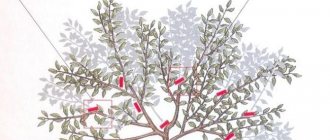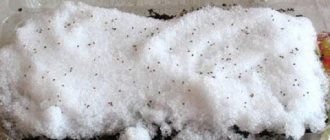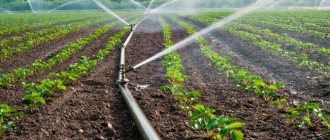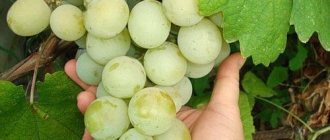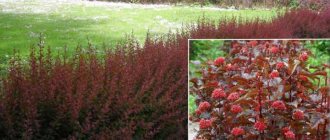Proper care of grapes in the fall not only increases the vine's resistance to frost, but is also the key to intensive development and health of plants in the spring, which is reflected in the size and quality of the berries next year.
The bulk of the work takes place in October, but you should start preparing grapes for winter in the middle zone already in the first half of September.
Planting grapes in autumn
When to plant grapes in the fall
Planting grape seedlings in autumn begins in the first weeks of October and ends with the onset of cold weather. The latest date is 8-10 days before the onset of the first frost. The justification for preferring autumn planting over spring planting is that at this time the buds are still dormant, and the root system is already developing, which is why the activity of young shoots begins in early spring of next year. Plus, if you just bought a seedling, you won't need to store it until spring.
The grapes are light-loving, so when choosing a place for them for many years, try to find an open area, protected from cold winds and drafts. It is not recommended to plant grapes near large trees, which will not only shade them from the sun, but will also not allow them to fully develop, sucking nutrients from the soil with their roots.
Grape seedlings in autumn
It is advisable to purchase seedlings from well-established sellers on the market, but this is not the only caveat. A high-quality seedling with an annual green shoot 40-50 cm high and a trunk thickness of 7-8 mm should have at least three light brown roots 10-15 cm long and at least 2-3 mm thick. The shoot should have well-ripened buds, and the roots should not be dry. Before planting, the shoots of the seedlings are shortened to 3-4 eyes, the roots at the upper nodes are cut off, and the remaining ones are lightly trimmed and placed in a heteroauxin solution for 12 hours.
How to plant grapes in autumn
Holes for grapes are dug in advance, measuring 50x50x60, a drainage layer of crushed stone or broken brick 5-7 cm thick is poured into them, thick paper is laid on top, a drainage pipe is installed under the wall of the hole, through which the bush is subsequently fed and watered. Then pour a couple of buckets of fertile soil, a glass of nitroammophoska, a handful of ash, a bucket of humus into the hole, mix everything thoroughly and then fill the hole to the top with earth. Fill the hole only with the top, fertile layer of soil; it is better not to use the bottom layer.
Now you need to water the hole generously several times, and you will see that the soil in it will settle. Let the pit stand for a couple of weeks after settling. You can’t plant grapes right away, because as the soil settles, it will pull the seedling deeper and tear its roots. It is best to start preparing the hole for autumn planting of grapes in early August. If you are planting several seedlings, the distance between the holes should be at least a meter.
During planting, a bucket of soil is poured into the center of the hole, a seedling is placed on it, the roots are straightened and the hole is filled with fertile soil until it grows. Short seedlings are placed vertically on a mound, and those taller than 25 cm are placed obliquely in the hole - the main thing is that the heel is at a depth of 50 cm, and the base of the growth is at a depth of 25 cm. After filling the hole, compact the soil and water the seedling generously with two or three buckets of water, and then cover it with a cut-off plastic bottle.
Autumn watering rules
After limited watering in late summer and harvesting, you need to saturate the bushes with moisture. Watering should not be frequent or abundant, but it must be necessary.
Winegrower's advice! If the soil is sandy, you need to pour water often and not a lot. Clay soil needs abundant and infrequent moisture.
In mid-October (for the middle zone), but before the onset of frost, you need to saturate the soil with moisture. The procedure will help create a frost-resistant barrier for the roots. The more moist the soil is, the less it is subject to freezing.
It is necessary to moisten the soil using the usual watering methods. Should be considered:
- If regular watering is used, be sure to loosen the soil after drying.
- The root irrigation system through a hole buried in the soil to a depth of 50 cm creates ideal conditions for moistening the soil. The roots are saturated with moisture, and the soil on the surface remains dry, which ensures the saturation of the roots with oxygen.
- You can also pour soil into drainage holes.
- Single bushes can be moistened by digging a hole at the root and pouring water into it.
Soil saturated with moisture can protect roots when temperatures drop to -20
Experienced winegrowers combine saturated watering with the application of fertilizers.
Autumn pruning of grapes
The timing of pruning grapes depends on the weather and climatic conditions in your region. The optimal time is when the first frost has passed, the vine has stopped growing wood, and its leaves have already fallen off.
To begin, remove the grapes from the trellis, remove the remaining mustaches, leaves, and stepsons. Trim off all unripe shoots. Then remove all short, thin (less than 5 mm in diameter), broken and diseased shoots.
Cut out the fruit shoots that bear fruit. If after this there are many annual shoots left, remove those that are not needed next year (growing on a trunk, from the ground, etc.). Trim the remaining vines, leaving 15 eyes on each.
Rules of care
Suitable fertilizers for grapes include phosphates, magnesium, which helps the plant not get sick, and manure. Manure is the main, but not the only element of fertilizer.
Some experts advise digging a pipe near the seedling and pouring in materials for fertilizing; you can also water the plants through it in extreme heat, when the soil dries out.
Somewhere within 1 m there should be a space free from other plants.
The serious point is the “haircut”. The peculiarity of the grape is its climbing “body”. The owner himself chooses the direction of growth by cutting off the antennae. Growth should be uniform so that the bushes are not subsequently overloaded with bunches.
Top dressing
A grape bush that is depleted of fruiting does not have sufficient resistance to cold and can freeze out during the winter. Conditions favorable for the development of fungi may form under the shelter (for example, due to thaws), and in this case, the health of the plants by spring will depend on their immunity, so sending weakened grapes to the shelter is dangerous.
To avoid negative consequences, the grapes must receive additional feeding in September. It is necessary to replenish the supply of nutrients, primarily potassium and phosphorus, as well as calcium, magnesium, copper, iron, manganese, zinc and boron. During this period, it is not recommended to give nitrogen, since the substance provokes the growth of green mass, while the grapes should go into a dormant phase. Only young plants do not need feeding, since the fertilizers added to the hole when planting should be enough for 3-4 years.
Phosphorus and potassium promote the aging of wood. Potassium, in addition, increases plant immunity and resistance to negative temperatures.
Fertilizer can be applied in liquid form, dry method or by spraying. For watering, it is necessary to dig a 10 cm deep groove around the bush at a distance of 40 cm so that the fertilizer does not spread, wetting the surface layer of soil, but reaches the roots. As a liquid fertilizer in the fall, you should choose one of the following options:
- 30-40 g of superphosphate and 20-30 g of potassium sulfate per 10 liters of water;
- 20-40 g of potassium monophosphate for the same volume;
- extract from 200-300 g of wood ash per 1 liter.
Microelements can be added to the nutrient solution or applied foliar. Spraying should be carried out in the evening: at this time the absorbency of the leaves is higher than during the day, and there is no bright sun that can burn wet greenery. For foliar feeding, the concentration of the substance must be reduced by 3 times compared to the volume calculated for irrigation:
- magnesium sulfate – 1 g per 10 liters;
- manganese sulfate – 2 g;
- boric acid – 1-2 g;
- zinc sulfate – 2 g.
The bush will receive copper and iron in sufficient quantities if treatment with copper or iron sulfate is used as a preventive measure for fungal diseases. Additional spraying should not be carried out to avoid plant poisoning.
If a foliar method is used to feed microelements, phosphorus-potassium fertilizer can be given in dry form. To do this, it is enough to embed 300 g of ash into the soil when digging or put 10-15 kg of rotted manure or compost in a furrow 20-25 cm deep, dug around the bush, and then water the plant generously. The fertilizer ditch should be made at a distance of at least 40-50 cm from the growing point. You can also apply manure mixed with wood ash in the form of mulch. Only well-rotted organic matter is suitable for autumn feeding, otherwise the grapes will receive an excess amount of nitrogen.
Disease and pest control
Treatment of the bush against pests and diseases should be carried out immediately after harvesting. It is necessary to stop the spread of insects or fungi on the grapevine as quickly as possible - this will increase the chances that damaged plants will have time to recover before winter. In addition, by winter, many pests turn into larvae, becoming invulnerable to some drugs.
In the case of autumn processing, the use of “chemistry” is justified, safe for the next year’s harvest, but more effective than biological and folk remedies.
- Depending on the type of pest, insecticides and acaricides should be used - “Aktellik”, “Oxychom”, “Dimethoate” and others.
- Against the fungus, you need to treat with 5% iron sulfate, and in October, after the leaves have fallen and pruned, spray with a 3% solution of copper sulfate.
- In addition to these measures, you can use biological products (Fitosporin, Glyokladin, Gamair, Trichodermin), but you should pay attention to the air temperature necessary to maintain the working properties of the product.
Healthy!
It is permissible to add urea to iron sulfate. A concentration of 1-2% of the substance in the spray solution is enough to destroy insect larvae (the product affects the external integument of insects).
If the treatment is preventive in nature, the following scheme is recommended:
- After harvesting, treat pests with lime mortar. To do this, pour 1 kg of quicklime into 3 liters of water and, after waiting for the reaction to complete, pour 7 liters of water into the solution.
- After the leaves fall, dig deep into the soil to destroy the mycelium and destroy the larvae overwintering in the soil.
- In the first half of October, spray with a solution of 10 tablespoons of salt and 5 tablespoons of soda per bucket of water.
- After pruning, bend the vines to the ground, preparing them for shelter.
- Shortly before insulating the bush for the winter, spray with 3% iron sulfate.
In this case, in the spring, after cleaning the shelter, it is necessary to treat the bushes with a 1% solution of copper sulfate. We should not forget that it is necessary to spray not only the vine, but also the soil in the tree trunk circle.
Treatment of grapes against diseases
A very important point in autumn grape care is treating (spraying) the vines with a fungicide before covering for the winter. The procedure will destroy pathogens of dangerous fungal diseases that may awaken in the spring, and also minimize the risk of mold development (during shelter).
The optimal time for treating vines in the fall is when all the leaves have fallen and the buds have completely closed, not earlier!
Iron sulfate is most often used as a fungicide. The dosage when preparing the solution depends on the condition of the vine:
- if it is a young bush, then it is better to use a 1% solution (100 grams of iron sulfate per 10 liters of water);
- if an adult shrub has not previously been exposed to diseases, then a 3% solution (300 g per 10 liters of water);
- if an adult shrub has previously suffered from fungal diseases, then you need to spray it with a 5% solution (500 g per 10 liters of water).
When treating grapes with a fungicide, do not forget to spray the soil around the plant to accurately eliminate all pathogens.
Caring for grapes in September and October
Autumn care for grapes has two goals: to lay the foundation for high-quality fruiting in the next season and to prepare the plant for the winter period. A bush is considered fully ready for winter if it is healthy, not affected by pests or diseases, has well-ripened wood, has recovered the energy spent on fruiting, and has entered a dormant state in time.
These tasks and growing conditions determine how to care for grapes in the fall. List of main works:
- last feeding of the season;
- grape pruning;
- catarrh of roots;
- protection against fungi and insects;
- pre-winter watering;
- shelter for the winter.
The quality of autumn care is especially important for late grape varieties, which have limited time for wood to ripen and life processes to slow down. When grown in a temperate climate, even medium-ripening varieties may not have time to prepare for winter. In view of this, it is recommended to follow two rules:
- You need to start autumn work as early as possible - as soon as the harvest from the vines is harvested. The preparation of early varieties of grapes must begin without waiting for the end of fruiting of the entire plantation.
- Care should be taken in advance to ensure that the vines are not overloaded. If a plant spends too much energy on ripening the crop, it will be difficult to restore it in a short time. It is worth sacrificing the volume of the harvest in favor of the bush and normalizing it by thinning out the bunches.
Sheltering grapes for the winter
After pruning and processing, bend the shoots as low as possible to the ground along the row and secure with pins so that the bush lies compactly.
Covering with soil
Covering with soil is the simplest and most effective method of insulation. Cover the grape bush secured with pins with soil 10-15 cm thick, and in late November - early December increase the layer to 25-30 cm. Under such a “blanket” the vine will not freeze at –15-20°C. And when the weather changes, the temperature in the shelter will not change too sharply.
Covering with straw or sawdust
You will need approximately 5-10 kg of straw or sawdust for covering per 1 linear meter of trellis. First, spread dry grass in a layer of 15-20 cm, and after about a month, increase the thickness of the straw “blanket” to 30-40 cm.
It’s easy to cover grapes with straw or sawdust, but they need to be trampled down immediately so that they don’t get blown away by the wind. In spring, such a shelter can be left under the bush as mulch and organic fertilizing. But if you use sawdust, keep in mind that soil bacteria consume a large amount of nitrogen to decompose it. Therefore, at the beginning of the new season, be sure to add an increased dose of nitrogen fertilizers to the soil under the grapes.
Shelter with spruce branches
Rodents do not like spruce spruce branches, and fungal diseases are not scary for them either. The layer of branches for covering should be about 30-40 cm thick.
In spring, fallen pine needles will become a wonderful organic fertilizer.
Combined shelter
Covering material can be combined. Here are some options:
- Layer of spruce branches (5-10 cm), cover with soil, peat or straw on top.
- Soil (10-15 cm), and a little later - straw, sawdust or fallen leaves in a layer of 30 cm.
- Straw (10-15 cm), on top - earth or peat.
It is not recommended to cover grapes with film, roofing felt or other material that does not allow air and moisture to pass through. With temperature changes (especially sudden ones), damping out of the eyes may occur.
Snow cover
Snow cover is the best mulch that nature has created. In winter, when snow falls, throw it on the vine. Even if you grow varieties that do not require shelter for the winter (Minsky pink, Violet August, hybrids 8-17, etc.), it is also better to insulate them. This way you are guaranteed to get a full harvest next year.
Pruning a grape bush
Forming the crown of grape bushes through pruning is one of the most creative and responsible activities when growing this fruit crop. The vine must be shaped in such a way that it can adapt to the local climate without impeding shelter for the winter.
Methods
There are several ways to prune a grapevine. Let's take a closer look at each of them.
Short
For this pruning method, leave no more than 4 eyes on the shoots. They are called bitches. Short pruning is carried out exclusively on young grapevines in order to strengthen the root system. Due to the fact that more than half of the annual shoots have been removed, dynamic development of the shoot from the bud occurs.
Average
This method is one of the most common among vineyard owners. Average pruning involves leaving no more than 10 eyes on the shoots. The branches on which bunches of grapes grow can take the form of a horizontal arc, or bend strongly towards the ground.
This method of forming a bush allows for high fruiting without compromising the quality of the berries.
Long
This method of pruning a grape bush requires the presence of no more than 20 eyes on the shoots. Long pruning is ideal for vigorous plants, often found in Central Asian grape varieties. If the procedure is carried out correctly, the grapes begin to bear fruit better in the next season.
Mixed
Fruiting pruning is an alternative name for mixed pruning. Quite often this method is used in small vineyards. Systematic cutting of a new shoot makes it possible not to lose high yields and juiciness of the fruit.
Pruning depending on the age of the grapes
One of the characteristics of grapes is the suspension of vine growth. This happens in connection with the formation of buds on the lower half of the plant, which causes the dynamic growth of shoots on last year’s vine. The bushes are expanding, and the distance from the root system to the crown is becoming greater.
This situation leads to a deficiency of nutrients in the root system, and it begins to wither. The solution to the problem was autumn pruning of the crown, which is carried out taking into account the age of the plant.
First year
In the first months of spring, it is necessary to leave the 2 lower buds of the plant and remove the rest. Subsequently, shoots will appear from these buds, which need to be fixed in such a way that they are inclined in different directions from each other.
When autumn comes, after the leaves have fallen from the vines, it is necessary to shorten the shoots. One of them is trimmed short, the next one is left unchanged. This leaves only 4 buds for the winter.
Second year
After the foliage on the plant has fallen, the long sleeves of the grape bush are pruned. Only 2 shoots are left. In this way, symmetry of the vines is achieved.
Then they begin to trim the vertical stems, that is, those located closer to the middle. Again, all shoots are cut off, with the exception of 2 buds. They will serve as “replacement knots”.
The remaining vertical stems, which are located along the edges, are also trimmed. This time you need to leave 4 buds, which will act as fruit shoots. After the manipulations have been completed, the grape bush can be prepared for winter.
Third and subsequent years
It is impossible not to mention that when spring comes, in the third year of growth of the vine, the grown fruit shoots are fixed in a horizontal position closer to the ground, while the tops of the bush are pulled vertically in different directions. The replacement knot should also grow in a vertical position.
During the summer season, the buds will produce new shoots in the form of young stems. By the end of August, the first cutting of the stems by 15 cm should take place. This procedure will soon provoke an increase in the juiciness and volume of the ripened berries.
It is worth noting that pruning carried out before August contributes to the appearance of a large number of unnecessary shoots on the vines.
Within a few days after the leaves fall, each of them will need to be pruned from fruit-bearing vertical shoots. All 4 outer shoots are cut off. Thus, each shoulder of the bush remains with one link of two vertical shoots.
Their pruning is carried out according to the same pattern as in the second year of grapevine growth. The shoots closest to the middle are also minted. Those located in the center are cut off, leaving only 2 buds.
The outermost shoots are also cut off, but this time 4 buds are left. Pruning in the following years will be carried out according to the same principle as described in the third year of growth of the grape bush.
If desired, you can leave more buds on the shoot. This is quite acceptable, since there is always a chance that several of them will be injured when frost sets in and the shelter is not good enough. However, it is not recommended to leave more than 10 buds on one shoot; this will provoke active growth of the vine.
Watch a video on how to tidy up a perennial grape bush by annually pruning excess vines and forming classic fruit links on all arms:
Pre-winter watering
Autumn care for grapes in September in the middle zone involves continuing watering as usual, with the exception of periods of rainy weather. Moisture deficiency prevents wood from preparing for the winter season.
It is especially important to maintain moisture if the grapes grow on sandy or sandy loam soil. In this case, you need to water the vineyard often, in small portions, but plants on clay soil or black soil need less frequent but abundant irrigation.
After the leaves have fallen off and the main pruning has been carried out, but before the soil has time to freeze, you need to do water-recharging watering. Water should be poured into trenches 10 cm deep around the bush. On average, you need to give 5 full buckets of water for each plant. Old and growing vines will need up to 10 buckets, young plants will need 10-30 liters. Sandy soil requires an increase in the watering dose to 6 buckets (relative to the average), and clay soil reduces it to 2.5-3 buckets.
Watering
Very often in winter there is freezing of shoots. This occurs from insufficient accumulation of moisture in the tissues of the vine. Therefore, it is necessary to water abundantly, or “charge” the vineyard in October - at least 50 liters of water for each bush. Such a charge of moisture guarantees a good entry into winter and will help you easily endure the cold period.
Often, winegrowers bury tubes in the soil around the bushes and pour water directly into them. With this method of watering, the liquid does not spread, but goes directly to the roots of the plant.
Watering grapes in the fall through special drainages
Fertilizing
By the time the harvest ripens, the grapevine gives all its strength, so nutrients are added in the fall. Timely feeding helps preserve flower buds and restore the plant's strength.
One of the most nutritious and safest remedies is humus. Rotted leaves are collected around the plant, mixed with turf, sprinkled around the bushes and dug up. Potassium fertilizers are added on top.
When planting new seedlings in the autumn, humus is first added to the planting hole.
Grape bushes love calcareous soils. Lime is quickly washed out of the soil, so it is applied regularly both in spring and autumn.
The vineyard is also fed with aqueous solutions of fertilizers. Take 10 g of aqueous extract of potassium fertilizers, 20 g of phosphorus fertilizers and dissolve in 10 liters of water. This mixture is poured into the soil around the bushes to a depth of 25 cm.
It is useful to add a solution of microelements to the irrigation mixture - iodine, potassium permanganate, boric acid, ammonium molybdate.
Wood ash is also used for feeding. Take 200 g per 1 m², scatter it around the bushes and lightly dig it up.
Nitrogen fertilizers are not applied in the autumn, as they promote the growth of green mass, and this leads to freezing of the plant.
If you do not fertilize grapes in the fall, spring fertilizing will not be able to compensate for the deficiency of nutrients in the soil.
How to fertilize grapes in October
The growing season and fruiting period weakens the vine in the fall, because the plant devotes a lot of energy to producing a harvest. In order for the bush to perk up, it should be fertilized with an aqueous solution of potassium and phosphorus fertilizer. Each square meter of nursery needs 25 g of each substance.
Potassium strengthens the rhizome of grapes, and phosphorus increases the immunity of shrubs. Also, potash fertilizers applied in mid-autumn guarantee a generous harvest next season. The soil in the garden is kept loose until winter.
The grapes are not fed with liquid organic fertilizers in October. It is better to seal the circle around the trunk with compost or a mixture of rotted manure and wood ash. The layer will protect the roots from freezing.
Preparing grapes for winter
Preparation of grape vines for winter begins from the moment of harvest in September and is carried out according to the following plan:
- Watering the bushes, from 60 to 100 liters of water for each bush;
- If necessary, catarrhosis;
- Fertilizing the soil with rotted manure and compost;
- Autumn pruning of vines;
- Treatment of the vine and the soil underneath it to prevent fungal diseases;
- Tilling the soil under bushes against wintering insects;
- Removing the vines from the trellis and bending them to the ground;
- Sheltering bushes for the winter in the middle zone is usually done by covering the vines pressed to the ground with old polypropylene bags and sprinkling them with 20-25 centimeters of soil on top. We described a more detailed description of these rules and how to properly prepare grapes for wintering in this article above.
What varieties are suitable for the Moscow region?
There are several varieties suitable for planting in the middle zone; they ripen quickly, they are classified as early ripening, which is quite convenient for areas where the weather is cool most of the year.
- Kishmish , there are several varieties. Its medium-sized, sweet, yellowish berries do not contain seeds and are easier to eat. The species is used in the preparation of sweets, in particular raisins. The harvest is harvested in September.
- " Lydia " is quite suitable for food, it is used in the production of white wine, the color of the berries is dark red with a green or lilac tint. It is resistant to fungal diseases, easily climbs trees or metal structures, and is highly fertile.
The list is not exhaustive and there are other varieties that are quite suitable for cultivation in the Moscow region.
Features of preparing and covering grapes for the winter in different regions
There are differences in the preparation and covering of grape bushes in different regions.
In the Moscow region, most often the grapes are either dug in and sprinkled with earth, as described above, or a wooden box is arranged around the bush, into which the vines tied into a bunch are carefully placed and the box is covered on top with available material: boards, roofing felt, spandbond, etc. When snow falls, it is recommended to bury the box in a snowdrift.
Sometimes they build a kind of greenhouse from low arches, under which grape vines are pinned to the ground and covered with hay or straw. You can also use branches and pine spruce branches instead of straw. Either a film or other covering material is pulled over the arches. Be sure to periodically open the sides of the film cover to avoid rotting of the vines.
In the Urals, they also use all the listed stages of preparing grapes for winter, as well as already known sheltering techniques. A special feature is that due to severe frosts and winds in the region, the covering material is folded in several layers.
Siberia is also a grape-growing region, and they invented their own way of covering bushes for the winter:
- The head of the grape plant is covered with a layer of light soil of 35-30 centimeters
- Carefully bend the previously shortened and tied into bunches branches to the ground.
- Each bunch is wrapped in any agricultural fabric with a high degree of thermal insulation. It is better if the canvas is folded in half.
- Spruce branches or tree bark, sawdust or boards are placed in a trench 20 centimeters high and up to 40 centimeters wide.
- The wrapped branches are placed in a trench, covered with spruce branches or corrugated cardboard, or foam plastic on top. And in some places they press with staples.
- The last layer of the entire structure is covered with roofing felt or film and covered with snow.
Save and share:
Watering grapes before wintering
Another event that must be carried out in the winter (after leaf fall and pruning, but before the soil freezes) is abundant moisture-recharging watering of the grape bushes in late autumn.
It is necessary to ensure that the plant receives a sufficient amount of nutrient moisture before wintering. This saturation with moisture prevents the root system from freezing in winter, since soil saturated with water freezes much less. In addition, a nourished vine wakes up earlier in the spring.
When watering, it is important to take into account the characteristics of the soil. So, if you have sandy soil, then you will need to pour about 50-60 liters of water under each adult bush (or along the trench), but on loam and black soil - 2 times less (25-30 liters).
Advice! To effectively carry out moisture charging, you need to dig a small depression in the form of a groove (10 cm deep) around the base of the trunk. This way, water will flow only to the root system, without spreading over a wide area. Or, if you planted grapes with a tube, it will be even easier.
By the way! In this case, much less water will be required.
Video: water-charging watering of grapes before wintering - methods
Difficulties in growing grapes in the Moscow region
Since ancient times, grapes have been grown on the southern slopes in countries with warm climates. Enthusiasts gradually spread the vine to the north. However, in the Moscow latitudes the crop could not produce a full harvest. There were not enough sunny days, a warm period for the grapes to ripen. Grapes have been used for a long time as an ornamental crop for producing arches and arbors, but now varieties of super-early and early selection have appeared, making it possible to obtain ripened bunches and wood prepared for wintering.
The grapes are given a place protected from cold winds and open to sunlight. The grape bush is particularly undemanding when it comes to soil, but fertilizing accelerates the development of the vine and the ripening of the berries. Whether a lover will get a grape harvest in the Moscow region depends on many factors:
- choosing a landing site;
- choice of variety or form;
- correct landing;
- plant care.
The grape bush is endowed with “smart” roots that will adapt to any soil except swampy soil. In the conditions of the Moscow region, the seedling is planted with an inclination to the ground, so that it can then be covered for the winter.
The landing site can be the southern wall of the building. Moreover, planting holes are made at a distance of 1 meter from the wall. Each bush is designed to be planted with the best lighting during the day. It is necessary to select grape seedlings for the Moscow region. Varieties are divided according to many characteristics. For the Moscow region, the choice of varieties with the characteristics of ultra-early, extra-early and early will become relevant. Other grape varieties do not ripen in the Moscow region.
The frost resistance indicator will be decisive for the Moscow region. It is necessary to select seedlings belonging to the first resistance group, which can withstand frosts of up to 35 degrees and above. However, for the Moscow region, it is recommended to insulate uncovered grape varieties for the winter.
The planting pit is prepared with a depth depending on the nature of the soil. The depth of the hole is prepared depending on the density of the soil, from 20 to 50 cm. After planting the plant, the hole is compacted and watered with warm water. You need to add organic fertilizers, superphosphate, wood ash, and potassium nitrate to the dressing mixture.
Before the material is planted, it needs to be prepared. It is necessary to remove the unpreserved roots of the seedling and dip the roots into a mash of one part of fermented mullein and two volumes of clay. Cut the upper part of the trunk along the shoots into two buds and lower them into melted paraffin or wax. The prepared seedling should be arranged obliquely so that later, when lowering the vine to cover it for the winter, it will not break off. Young plants should be watered until established and allowed to begin to form just two vines.
How to water young grapes
Depending on the climatic conditions of the area, the number of irrigations varies. In the southern, arid regions, young plantings are watered more often than in the northern regions and in places with close groundwater. Young vineyards usually require more watering than fruit-bearing ones.
When watering bushes, special attention is paid to good moistening of the soil layer where the roots lie. It is not the amount of watering that is important, but the depth of soil moisture, because the roots of the grapes are quite deep and surface watering is not effective. For complete watering, holes 18-20 cm deep or wells to the planting depth are made around the bush, which are filled to the top with water. After absorbing the water, they are covered with earth.
It is very effective to water directly into the roots of the plant through a feeding unit, which is installed in the planting hole.
The first watering after spring planting is given after 10-15 days, the second - 20-25 days after the first, at the rate of one or two buckets of water per plant. Watering is best done in the evening with water warmed in the sun.
After the plants take root and shoot growth reaches 8-10 cm, the next two or three waterings are combined with fertilizing. The last watering is carried out no later than the beginning of August. After each watering or rain, loosen the soil to prevent crust formation.
Irrigation should be carried out with special attention in areas with very dry summers and in places with close groundwater levels. In the first case, the bushes are watered very often, and in the second, on the contrary, rarely. When the water is close, the soil moisture at the beginning of summer is always higher, and its temperature is lower than in areas with deep groundwater. Excessive watering and especially cold water in such places can cause poor survival of seedlings.
What to do if the grapevine does not ripen
If the vine is still green, and winter is close (it’s time to cover), then it is necessary to take measures aimed at forcing it to ripen.
Well-ripened grapevine
Important! There is no need to delay harvesting, otherwise the vine simply will not ripen. If the variety is late in ripening and the branches are still overloaded with clusters of unripe fruits, then it is recommended to cut them off as quickly as possible. It is better to lose part of the harvest than to lose grape bushes.
You can speed up the ripening of grapevines in the following ways:
- Stop watering at the end of fruiting (the second half of August-September), or only combine it with potassium-phosphorus fertilizing (if it is hot at the beginning of autumn).
Note! Moisture-charging watering is carried out after fruiting and ripening of shoots.
- Carry out foliar feeding (in September): spraying the leaves with phosphorus-potassium fertilizers also improves the ripening of the vine (you need to dissolve 20-30 grams of each fertilizer per 10 liters of water).
- Provide increased heat (in October). To do this, you need to remove the grapes from the trellises, lay them on the ground and cover them with one of the insulation materials, for example, spunbond or lutrasil.
Video: how to improve vine ripening
Thus, the quality of the work done to care for the grapes in the autumn and their preparation for winter, the more effectively the efforts of the winegrower will be rewarded next year. And this requires a very responsible and thoughtful approach to the issues of fertilizing, watering, pruning, treating diseases and pests, as well as covering the grapes for the winter. Rich harvests!
Video: how to prepare grapes for winter - step-by-step instructions

